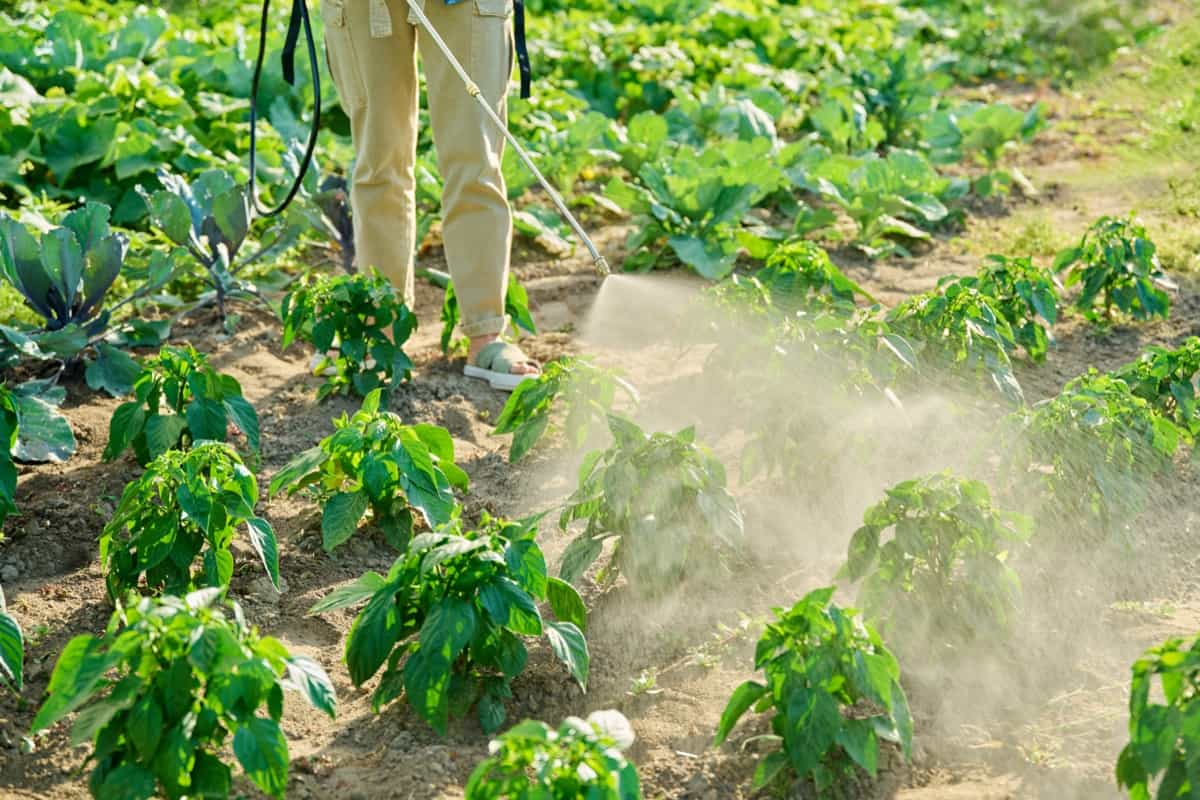Organic gardening has become increasingly popular in recent years as people become more aware of the potential risks of chemical pesticides. One of the key advantages of making your organic insecticide spray is that you have complete control over what goes into it. Another advantage is cost savings.

Commercial organic insecticides can often be expensive, especially if you have a large garden. By making your spray at home, you can save money while effectively managing pests. Making your organic insecticide spray also allows customization based on specific pest problems and plant types. Different plants may attract different pests, so having the ability to tailor your spray to target those insects can be incredibly effective.
How to Make Organic Insecticide Spray
Follow Step-by-step Instructions to Create Organic Insecticide Spray at Home
Creating organic insecticide spray is a simple and cost-effective way to protect your garden from pests without harmful chemicals. By making your DIY spray, you have full control over the ingredients and can ensure that it is safe for humans and the environment. To start, gather the necessary ingredients for your homemade insecticide spray. Some common options include Garlic, Neem oil, essential oils such as Peppermint or Lavender, dish soap, and water.
These natural ingredients work together to repel insects while being gentle on plants. Once you have your ingredients ready, it’s time to mix them. Start by diluting the neem oil in water according to the instructions on the bottle. Then, add crushed Garlic cloves or a few drops of essential oil into the mixture.
Add a small amount of dish soap as an emulsifier. After thoroughly mixing all the components, transfer your homemade insecticide spray into a clean spray bottle. Labeling it properly is important so you know what it contains and how long it will remain effective. When applying the spray, cover both sides of the leaves and target areas where pests are commonly found. It is best applied early or late evening when temperatures are cooler and beneficial insects are less active.
Find Out What Ingredients You Need for DIY Organic Insecticide Spray
One key ingredient in many homemade insecticide sprays is Garlic. Garlic has natural pesticide properties that can prevent insects from damaging your plants. Another common ingredient is hot peppers. Crushed or powdered hot pepper flakes can be added to the mix. Neem oil is another powerful ingredient that can be used in organic insecticide sprays. Derived from the neem tree, neem oil disrupts the life cycle of many pests and acts as an effective repellent.
In case you missed it: Homemade Insecticide for Chilli Plants: DIY Remedies for Natural Pest Control for Chili Peppers

Essential oils like peppermint, rosemary, and lavender are fragrant and have insect-repellent properties. These oils can be added to your homemade spray mixture to enhance its effectiveness against pests. Liquid soap is often included as an emulsifier in organic insecticide sprays. It helps the other ingredients mix well with water and adhere better to plant surfaces when sprayed.
Stay Safe While Using Organic Insecticide Sprays With These Precautions
- Read the instructions carefully: Before using organic insecticide spray, read and follow the instructions provided by the manufacturer.
- Wear protective clothing: When applying organic insecticide sprays, it is recommended to wear long sleeves, pants, gloves, and goggles to protect your skin and eyes from potential irritation or allergic reactions.
- Avoid spraying on windy days: Windy conditions can cause the spray to drift onto unintended areas or people nearby. Choose a calm day with minimal wind for optimal application.
- Keep children and pets away: To ensure their safety, keep them away from treated areas until the spray dries completely.
Apply Organic Insecticide Sprays Effectively Using Recommended Techniques
Timing is crucial. It’s best to spray your plants early or late in the evening when temperatures are cooler and the wind is calmer. This will prevent the spray from evaporating too quickly or drifting away. Cover both sides of the plant leaves thoroughly with the organic insecticide spray.
Additionally, remember not to over-saturate your plants with the spray. A light and even misting should suffice for most applications. Too much liquid can damage delicate foliage or cause runoff into nearby water sources. Furthermore, consider rotating different types of organic insecticides throughout the growing season. This helps prevent pests from building up resistance and ensures they remain effective against various insects. Moreover, keep in mind that persistence pays off when controlling pests naturally.
Compare the Differences Between Commercial and Homemade Organic Insecticide Sprays
When protecting your garden from pests, there are two main options: commercial organic insecticide sprays and homemade ones. Commercial organic insecticide sprays can be convenient because they are readily available at stores. They often come in ready-to-use formulations, saving you time and effort. However, they can be quite expensive compared to making your spray at home.
Homemade organic insecticide sprays offer a more cost-effective solution. You can control the ingredients and customize the spray according to your needs. Plus, making your spray allows you to avoid chemicals that might be present in commercially produced products. However, homemade sprays require more time and effort since you must gather the ingredients and prepare the solution yourself.
In case you missed it: Homemade Insecticide for Orchids: Homemade Remedies for Natural Pest Control on Orchids

Finding the right combination of ingredients for effective pest control may also take some trial and error. Another difference is that commercial sprays often come with detailed instructions on using them safely and effectively. On the other hand, when making your spray, you need to rely on research or expert advice for proper application techniques.
Understand the Environmental Impact of Using Organic Insecticide Sprays
One positive aspect of organic insecticide sprays is that they are typically made from natural ingredients such as essential oils, neem oil, and soap. These ingredients break down more easily in the environment than synthetic chemicals in conventional insecticides. As a result, there is less risk of long-term harm to soil quality or water sources. However, it’s important to note that organic insecticide sprays can impact non-target organisms, such as beneficial insects like bees and butterflies.
While these products are generally considered safer for beneficial insects than their chemical counterparts, it’s still necessary to use them judiciously and follow recommended application techniques. Another consideration is the potential for runoff into nearby ecosystems. When sprayed onto plants or soil, organic insecticides may be carried away by rainwater or irrigation runoff and enter streams or bodies of water. This can affect aquatic life if not properly managed.
Learn How to Store and Preserve Homemade Organic Insecticide Spray
Choose the appropriate container for storing your insecticide spray. Opt for a dark-colored glass bottle or an opaque plastic container. This will help protect the potency of the ingredients by minimizing exposure to sunlight. Next, find a cool and dry place to store your homemade spray. Avoid areas with extreme temperatures, as this can degrade its effectiveness over time.
In case you missed it: Homemade Insecticide for Roses: Homemade Remedies for Natural Pest Control on Rose Plants

Labeling your container clearly with the product’s name, creation date, and any safety precautions or instructions for use is crucial. This will prevent confusion and ensure you use it correctly when needed. To extend the shelf life of organic insecticide spray, consider adding natural preservatives such as essential oils. These enhance its scent and act as antimicrobial agents that can help prolong its efficacy.
Identify Common Pests That Organic Insecticide Sprays Can Target
Organic insecticide sprays can be a game-changer when protecting your garden from pesky pests. One common pest that organic insecticides can help control is aphids. These tiny insects have a knack for infesting plants and sucking the life out of them. You can effectively repel and eliminate aphids from your garden using an organic spray containing ingredients like Neem oil or Garlic.
The dreaded tomato hornworm is another troublesome pest that organic insecticide sprays can tackle. These caterpillars are notorious for devouring tomato plants in no time. With the right organic spray infused with ingredients such as chili pepper or vinegar, you can deter these hungry critters and protect your precious Tomatoes. Suppose slugs and snails are wreaking havoc on your garden.
In that case, Organic insecticides made with diatomaceous earth or copper sulfate can provide a barrier against these slimy invaders without harming beneficial organisms in your soil. Essential oils like peppermint or rosemary mixed with water make excellent repellents against these tiny yet destructive pests. You can take control of the situation naturally and effectively by identifying the pests plaguing your garden and choosing an appropriate homemade organic insecticide spray recipe targeted towards them.
Use Essential Oils in Your Organic Insecticide Sprays for Better Results
Essential oils have gained popularity not only for their aromatic properties but also for their potential as natural insecticides. One popular essential oil used in organic insecticide sprays is peppermint oil. Its strong scent deters common garden pests, such as aphids and ants. Mixing 2 to 3 drops of peppermint oil with water and liquid soap creates an effective spray that can be applied to infested parts. Another essential oil with pest-repelling properties is lavender oil. It has been found to repel mosquitoes, flies, and moths due to its floral scent.
In case you missed it: Homemade Insecticide for Hibiscus: Homemade Remedies for Natural Pest Control on Hibiscus Plants

Adding two drops of lavender oil to your homemade insecticide spray can help protect your garden from these annoying insects. Tea tree oil is another potent essential oil known for its antifungal and antibacterial properties. When used in an insecticide spray, it can combat fungal diseases that affect plants and deter pests like whiteflies and spider mites. Citronella oil is extracted from certain species of grasses.
You can create an effective barrier against these blood-sucking insects by incorporating citronella into your organic insecticide spray formula. Eucalyptus oil is another essential oil that acts as a natural pesticide, targeting specific pests like aphids, whiteflies, and caterpillars. Its strong aroma confuses insects’ sensory systems and disrupts their feeding patterns. When using essential oils in your DIY organic insecticide sprays, it’s important to remember that they should always be diluted properly before application.
Harness the Power of Neem Oil in Organic Pest Control
Neem oil is a powerful insect repellent, inhibiting their feeding and reproduction. When sprayed on plants, neem oil creates a protective barrier that deters pests from infesting your garden. Another advantage of using neem oil is its low toxicity to humans and beneficial insects. Unlike chemical pesticides, which can harm pests and beneficial organisms like bees and ladybugs, neem oil targets specific pests while leaving other creatures unharmed.
To make your neem oil spray, mix 28 grams of pure cold-pressed neem oil with one gallon of water. Add 2 to 3 drops of dish soap to help emulsify the mixture. Spray this solution directly onto your plants, covering both sides of the leaves. Remember to apply neem oil during cooler parts of the day or in the evening when bees are less active to minimize any potential impact on pollinators.
Explore the Role of Soap in Organic Insecticide Sprays
Soap acts as a surfactant in insecticide sprays, disrupting the surface tension of water and making it easier for the spray to spread and stick to plants. This allows better coverage and contact with pests. The soap also helps smother soft-bodied insects like aphids and mites by coating their respiratory systems. When using soap in your homemade organic insecticide spray, choosing natural soaps without additives or fragrances is essential.
Castile soap is often recommended due to its gentle yet effective properties. Mix two tablespoons of liquid castile soap and water to create an organic insecticide spray with soap. Shake well before spraying on plants affected by pests. Remember that while using soap can be an effective method for pest control, it’s crucial not to overdo it. Excessive use may harm beneficial insects or damage sensitive plant species.
Look Into Herbal Solutions for Managing Pests in an Organic Way
Going the organic route can be highly effective when managing pests in your garden. One approach you may want to consider is using herbal solutions as a natural pest control method. Herbs such as Mint, Lavender, and Rosemary have been found to repel insects like mosquitoes, flies, and ants. You can create a homemade spray by steeping these herbs in water and then spraying it onto affected areas or pests. Another option is using essential oils derived from citronella, eucalyptus, and lemongrass.
In case you missed it: Homemade Insecticide for Houseplants: Homemade Remedies for Natural Pest Control on Houseplants

These oils are known for their strong scents that deter insects. Mix a few drops of these oils with water or carrier oil (such as coconut oil) and apply them around your garden or on specific plants where pests gather. Additionally, certain flowers like Marigolds and Chrysanthemums contain natural insecticides called pyrethrins, which are toxic to many common garden pests but safe for humans and animals when used properly. Planting these flowers around your garden adds beauty and protects against unwanted bugs.
Frequently Asked Questions on Making Organic Insecticide Spray
How Often Should I Apply Organic Insecticide Spray?
The frequency of application will depend on the severity of your pest problem. Generally, it’s recommended to apply the spray every 7-10 days or after heavy rainfall.
Is Homemade Organic Insecticide as Effective As Commercial Products?
Homemade organic insecticides can be just as effective when used correctly. However, it’s important to note that their efficacy may vary depending on factors such as pest type and infestation level.
Conclusion
By making your organic insecticide spray, you can protect your garden from pests while avoiding the harmful effects of synthetic chemicals. Remember to choose safe ingredients for both humans and beneficial insects, such as Neem oil, Garlic, and dish soap. When applying the spray, follow proper precautions and consider doing it during cooler times when bees are less active.
Using organic insecticide sprays offers several benefits, including reduced harm to beneficial insects like pollinators, avoidance of chemical residues on fruits and vegetables, and overall environmental sustainability. Plus, it’s cost-effective because you can make it home with minimal effort.
- Broccoli Seed Germination and Selection
- Asparagus Seed Germination and Variety Selection
- Seasonal Flower Gardening: Best Practices for Spring, Summer, Fall, and Winter
- How to Grow Hibiscus from Flower
- Plantation Ideas for Home Decoration: A Beginners Guide
- Flower Garden Designs and Layouts for Beginners
- Planting and Spacing Techniques in Papaya: A Beginner’s Guide
- Growing Gold: Essential Techniques for Planting Pineapples
- How to Make Kalanchoe Plant Bushy: Home Remedies and Solutions
- 11 Reasons Why Your Gardenia is Not Blooming: Home Remedies and Solutions
- Eco Elegance: The Guide to Designing a Drought-Tolerant Landscape
- Gardening on a Slope: Strategies for Hillside Landscaping
- Nourish and Flourish: Top Organic Mulches for Thriving House Plants
- Everything You Want to Know about Indian Mogra Flower: Discover Uses and Growing
- Green Thumb Success: Expert Tips for Cultivating Greenhouse Pumpkins All Year Round
- Maximize Growth & Flavor: The Ultimate Guide to Companion Planting in Herb Gardens
- How to Control Rhododendron Problems Naturally: Home Remedies and Organic Ways to Fix Them
- Natural Magic: The Remarkable Benefits of Cinnamon for Plants
- Best Steps to Revive Dying Tulip with Natural and Organic Treatment
- 10 Reasons Why Your Angel Trumpet is Not Blooming: Remedies and Treatment
- How to Fix Periwinkle Leaf and Flower-Related Problems: Natural Remedies and Solutions
- How to Fix Zinnias Leaf and Flower Problems: Discover Natural and Home Remedies
- Organic Steps to Induce Lemon Tree Flowers: A Comprehensive Guide
- Bloom Booster: Crafting the Perfect Homemade Bougainvillea Fertilizer
- Optimizing Growth: A Guide to Applying NPK Fertilizer for Potted Plants
- 10 Best Homemade Fertilizers for Rubber Plant: DIY Recipes and Application Method
- How to Boost Female Pumpkin Flowers: Effective Steps for More Flowers and High Yields
- Transform Your Indoor Garden: Top Benefits of Pink Salt for Houseplants
- 10 Best Homemade Fertilizers for Peacock Plants (Calathea): Easy DIY Guide
- Unlock Blooms: 9 Reasons Why Your Potted Chrysanthemum is Not Blooming
- 8 Reasons Why Your Potted Hibiscus is Not Blooming: Fix it with Simple Solutions
- Unlock Blooms: 9 Key Reasons Your Potted Frangipani Won’t Flower
- 10 Reasons Why Is My Ice Plant Not Blooming: Remedies and Treatment
- 10 Reasons Why My Potted Hydrangea Not Blooming: Treatment and Remedies
- 10 Reasons Why is My Wisteria Not Blooming: Remedies and Treatment
- 10 Reasons Why is My Goldfish Plant Not Blooming: Remedies and Treatment